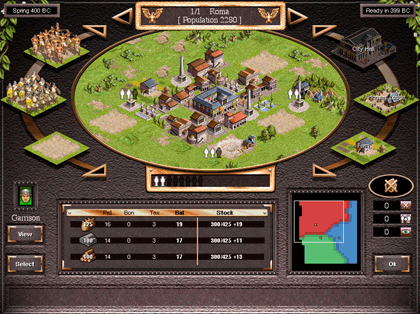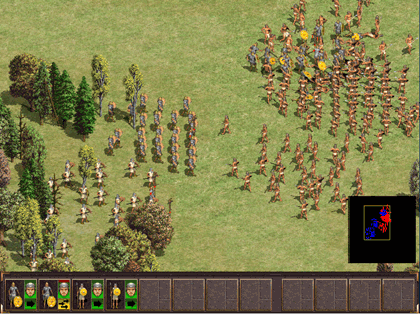Review: Legion 1.0

Developer: Slitherine Software, Virtual Programming, Ltd., Freeverse Software
Price: $19.95 (from Freeverse Software); £19.95 including VAT (from VirtualProgramming)
Requirements: G3 Macintosh with New World ROM, 64 MB RAM, 8 MB VRAM, 240 MB disk space, Mac OS X 9.2 or Mac OS X10.1.3.
Recommended: 800 MHz G3, 128 MB application RAM, 16 MB VRAM.
Trial: None
Overview
Legion is a turn-based strategy game similar to Civilization, Caesar, and Age of Empires. Its use of formations is reminiscent of the Mac Plus-era game The Ancient Art of War. Essentially, you manage city resources, raise and train armies, and attack or negotiate with neighboring city-states. You win if your power greatly exceeds that of your opponents.
Installation
Legion is installed by dragging the folder from the CD to your hard drive. The Legion CD must be mounted in order to launch the game; this is probably an anti-piracy measure, but Legion will work with a disk image of the CD in place of the physical CD.
Playing Legion
You begin by selecting New Game from the main menu screen. You then select a campaign and choose a nation to play. Legion has four campaigns plus a tutorial. Each campaign has a historical setting and a number of alternative settings. Once you’ve selected your campaign options, the game begins.

Campaign Selection
Each turn in Legion represents a season. During each turn you may begin the construction of new buildings or facilities (farms, mines, stables, shrines, barracks, etc.). However, regardless of when you begin construction, completion is always in the spring. During each turn you may reorganize and move your armies or begin an attack on a nearby enemy city or army. Finally, during each turn you may access the Diplomacy Screen and interact with any of your opponents. Options include declaring war, offering peace, forming or breaking alliances, paying tribute, and acquiring information.
The Empire Overview screen lists your cities and their populations, resources (food, ore, and wood), buildings under construction, and units being trained. Clicking the View button takes you to the highlighted city. You can also access a city by clicking on it in the Campaign Screen.

Empire Overview
City design and resource maintenance are important because they determine the kind of armies you can field and how large a population you can support. For example, you cannot field archers without building a fletcher, and the fletcher is worthless without a lumber mill. To field large armies you need a barracks (for training) and a quartermaster.
Unlike most other empire building games, Legion limits the size of your cities. You begin with a village and can eventually grow to a town and then a city. You do this by replacing the Village Hall with a Town Hall and the Town Hall with a City Hall. Of course, it takes time and proper planning to grow from a village to a city. You begin with a limited number of persons (who will either work or be recruited into your army), resources, and money. With proper management, you can increase the resources, wealth, and population of your cities.

City Screen showing the small oval area available for buildings.
The main focus of Legion is on organizing, moving, and using your armies. This is done via the Campaign Screen, the Strategic Map, and the Deployment Screen. The choice of army units available depends on the nation you have selected. Legion mixes strategy (army composition, size, and placement) with tactics (unit placement, formation, and movement). When your army comes into contact with an opponent, you use a Deployment Screen to implement your tactics.

Legion Deployment Screen
The Deployment screen represents the area of combat and has a crude representation of the terrain. Each unit of your army is represented by a rectangle. You drag the rectangles to desired starting positions. You choose the formation for each unit that will hopefully work best against your opponent. Finally, you issue movement orders to each unit. These are relatively crude commands, such as “hold for a few seconds and then advance.” When you have completed these tasks, clicking the OK button displays live-action fighting on the Battle Screen.

Battle screen showing live combat. Insert shows unit locations for the entire field of combat.
You have no control over the battle at this point. For example, if your units are being decimated you cannot order a retreat. Instead, your units respond to the situation depending on their characteristics (unit type, training, and experience) and on their morale (which will be low if the battle is going badly). Units may fight and win, fight and die, or fight and flee (and often die while running). The lack of control during battle supposedly mimics the reality of poor communications during ancient combat, but even in those ages leaders could communicate with units via signal flags or sound (horns or drums).
Diplomatic options seem to have only a minor role in Legion. In my brief exposure to the game, very few alliances were offered or accepted. Neighboring nations often declared war immediately, without giving you a chance to negotiate or pay tribute.
Documentation
Legion comes with a 36-page printed manual. The entire manual is difficult to read due to very small type and an underlying gray reproduction of a map in the background. The manual gives only bare-bones descriptions of game play. It also describes the many different types of military units. There is no information on strategy or tactics.
Technical Support
Paradox Entertainment maintains a Legion Forum Web site. Slitherine Software has a FAQ Web page. No true technical support is available for Legion, not even by e-mail or Web form.
Problems and Bugs
I had no problems installing or running Legion on our test machine. It seems remarkably stable.
Wish List
I’d like to have simple live battle commands such as hold, advance, charge, and retreat. Construction and training should take a fixed number of turns (instead of being completed only in the spring). The ability to build roads (we are talking about Romans, after all) should be included. A more complete manual and strategy guide would be helpful.
Other Reviews of Legion
Alternatives
Civilization II, Caesar III, and Ages of Empire (turn-based games) and the Warcraft series (real-time games) are older alternatives that I found more entertaining than Legion. Newer turn-based strategy games with good reviews include Master of Orion III, Civilization III, Age of Empires II, and Heroes of Might and Magic IV.
Summary
Legion performed as expected, had decent graphics, and was quite stable. However, I did not enjoy the game. City and resource management were too limited. Diplomacy seemed almost irrelevant to the historical campaigns. Tactical control of army units was too crude.
Reader Comments (6)
I like the fact that this is not a game you can just play one way or one time for that matter. You have the chance to conquor other nations different ways and you can start in a different place with different settings find that to be good variety!
Add A Comment